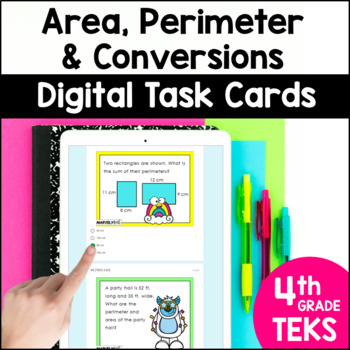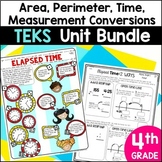4th Grade Area, Perimeter, Measurement Conversions - Online STAAR Review
- PDF
- Google Apps™
- Easel Assessment

What educators are saying
Also included in
- This TEKS centered Measurement Unit for 4th Grade covers area and perimeter, measurement conversions, relative sizes of measurement, and elapsed time word problems. Both the metric and customary measurement system are covered. This unit is complete with everything you need to confidently teach, reviPrice $25.00Original Price $41.50Save $16.50
- Everything you need to teach 4th grade math TEKS for the ENTIRE SCHOOL YEAR! This bundle includes the TEKS based Math Units 4th grade Texas teachers have been raving about! This year-long bundle gives you ALL the resources you will need to teach the 4th grade math TEKS easily, and without the stressPrice $189.25Original Price $378.50Save $189.25
- This is a great digital 4th grade STAAR review resource to add to your teacher toolbox! Your students will love these fun and engaging digital math task cards to review all the 4th grade math TEKS. There are 8 sets in all, making these math activities easy to use throughout the year, or as an end ofPrice $18.00Original Price $32.00Save $14.00
Description
Your students will love this fun and engaging review, and You will love that it is No Prep! This resource includes 24 TEKS-aligned Digital Task Cards for Perimeter, Area, Elapsed Time, Conversions, Relative Size of Measurement Units and Money.
This resource includes 24 TEKS-aligned Digital Task Cards for Measurement that can be assigned for Math Station Work, Homework, or online STAAR Review. This resource is included in 2 forms: a Google Form and an Easel Assessment. Google Forms can be assigned in Google Classroom or any platform compatible with Google Forms. Easel Assessments can be assigned directly through TpT! Both versions give students instant feedback and are self-grading!
Save Money on this Resource by Purchasing it in a Bundle
Save 40% on individual sets by purchasing the 4th Grade bundle of Self-Grading Task cards.
Save 50% on this set by purchasing the 4th Grade Area, Perimeter, Elapsed Time, Measurement Conversions Bundle.
Save even more on this set when you purchase the 4th Grade TEKS Year-Long Bundle!
Click HERE to see the printable version of this product.
This set includes Task Cards to help students practice all of the Measurement Standards.
What's Included?
- 24 Digital Task Cards with STAAR formatted questions
- Printable Teacher Tracking Sheet to record names of students who are struggling with each of the TEKS (based on the problem numbers they missed)
- PDF with a Link to make a copy of the Google Form version in your Google Drive
- Easel Assessment version that can be assigned directly through TpT to students
Topics include:
- Perimeter
- Area
- Elapsed Time
- Conversions
- One and Multi-Step Word Problems with Conversions
- One and Multi-Step Word Problems with Money
- Relative Sizes of Measurement Units
I have designed these task cards to give more weight to the Readiness Standards which comprise nearly 2/3 of the STAAR test, and are the most important skills to prepare students for the next grade level. The questions are rigorous and have bright graphics to keep students engaged. All questions are multiple choice.
Please note that the questions are NOT editable.
TEKS alignment:
Readiness Standards
4.5D (8 Questions): Solve problems related to perimeter and area of rectangles where dimensions are whole numbers.
4.8C (6 Questions): Solve problems that deal with measurements of length, intervals of time, liquid volumes, mass, and money using addition, subtraction, multiplication, or division as appropriate.
Supporting Standards
4.8A (4 Questions): Identify relative sizes of measurement units within the customary and metric systems.
4.8B (4 Questions): Convert measurements within the same measurement system, customary or metric, from a smaller unit into a larger unit or a larger unit into a smaller unit when given other equivalent measures represented in a table.









